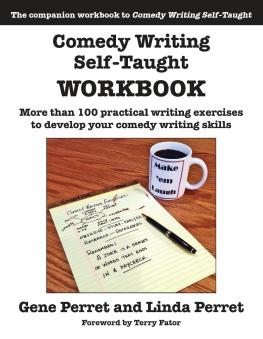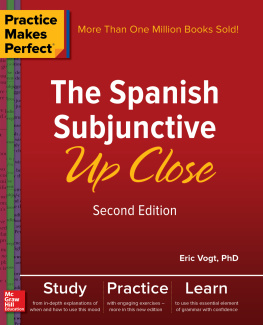PRACTICE MAKES PERFECT
Mastering Writing
PRACTICE MAKES PERFECT
Mastering Writing
Gary Robert Muschla


Copyright 2011 by Gary Robert Muschla. All rights reserved. Printed in the United States of America. Except as permitted under the United States Copyright Act of 1976, no part of this publication may be reproduced or distributed in any form or by any means, or stored in a database or retrieval system, without the prior written permission of the publisher.
ISBN: 978-0-07-174838-4
MHID: 0-07-174838-5
The material in this eBook also appears in the print version of this title: ISBN: 978-0-07-174716-5, MHID: 0-07-174716-8.
All trademarks are trademarks of their respective owners. Rather than put a trademark symbol after every occurrence of a trademarked name, we use names in an editorial fashion only, and to the benefit of the trademark owner, with no intention of infringement of the trademark. Where such designations appear in this book, they have been printed with initial caps.
McGraw-Hill eBooks are available at special quantity discounts to use as premiums and sales promotions, or for use in corporate training programs. To contact a representative please e-mail us at bulksales@mcgraw-hill.com.
Trademarks: McGraw-Hill, the McGraw-Hill Publishing logo, Practice Makes Perfect, and related trade dress are trademarks or registered trademarks of The McGraw-Hill Companies and/or its affiliates in the United States and other countries and may not be used without written permission. All other trademarks are the property of their respective owners. The McGraw-Hill Companies is not associated with any product or vendor mentioned in this book.
TERMS OF USE
This is a copyrighted work and The McGraw-Hill Companies, Inc. (McGraw-Hill) and its licensors reserve all rights in and to the work. Use of this work is subject to these terms. Except as permitted under the Copyright Act of 1976 and the right to store and retrieve one copy of the work, you may not decompile, disassemble, reverse engineer, reproduce, modify, create derivative works based upon, transmit, distribute, disseminate, sell, publish or sublicense the work or any part of it without McGraw-Hills prior consent. You may use the work for your own noncommercial and personal use; any other use of the work is strictly prohibited. Your right to use the work may be terminated if you fail to comply with these terms.
THE WORK IS PROVIDED AS IS. McGRAW-HILL AND ITS LICENSORS MAKE NO GUARANTEES OR WARRANTIES AS TO THE ACCURACY, ADEQUACY OR COMPLETENESS OF OR RESULTS TO BE OBTAINED FROM USING THE WORK, INCLUDING ANY INFORMATION THAT CAN BE ACCESSED THROUGH THE WORK VIA HYPERLINK OR OTHERWISE, AND EXPRESSLY DISCLAIM ANY WARRANTY, EXPRESS OR IMPLIED, INCLUDING BUT NOT LIMITED TO IMPLIED WARRANTIES OF MERCHANTABILITY OR FITNESS FOR A PARTICULAR PURPOSE. McGraw-Hill and its licensors do not warrant or guarantee that the functions contained in the work will meet your requirements or that its operation will be uninterrupted or error free. Neither McGraw-Hill nor its licensors shall be liable to you or anyone else for any inaccuracy, error or omission, regardless of cause, in the work or for any damages resulting there from. McGraw-Hill has no responsibility for the content of any information accessed through the work. Under no circumstances shall McGraw-Hill and/or its licensors be liable for any indirect, incidental, special, punitive, consequential or similar damages that result from the use of or inability to use the work, even if any of them has been advised of the possibility of such damages. This limitation of liability shall apply to any claim or cause whatsoever whether such claim or cause arises in contract, tort or otherwise.
Contents
Part 1
Finding and Developing Ideas for Writing
Part 2
Writing the Draft
Part 3
Revision
Part 4
Proofreading
About This Book
Learning to write is a challenging, multiskilled process. Students must learn how to identify, analyze, and develop ideas. They must learn how to compose sentences, build paragraphs, and express ideas within the standards of written English. They must discover their voice and learn how to say precisely what they want to say with fluency, clarity, and energy.
Practice Makes Perfect: Mastering Writing can be a valuable resource for developing writing skills. It can be used by both students and teachers. Students (working alone or with their parents) can complete the exercises and worksheets to improve their writing, while teachers will find the materials of the book to be useful for classroom instruction or to supplement their writing program.
The exercises and worksheets in this book provide students with meaningful writing assignments and activities. They will learn how to find and focus ideas for writing; how to write a draft; how to revise their writing; and how to proofread their work. This book, which is based on the stages of the writing process, will give students the practice they need to acquire the skills for effective composition and to grow as young writers.
Learning to write is a difficult task. It is my hope that you will find this book useful in that demanding and rewarding challenge.
How to Use This Book
Practice Makes Perfect: Mastering Writing is divided into four parts that concentrate on writing skills, from developing ideas to proofreading. The book includes exercises and worksheets. An answer key for the worksheets is included at the end of the book.
Part 1 Finding and Developing Ideas for Writing begins with the understanding that solid ideas are the foundation of good writing. Ideas are everywhere, and you simply need to learn how to identify and develop ideas for your writing. This part of the book includes information on idea development, six exercises, and a hundred reproducible worksheets designed to help you develop material for writing. The worksheets are broken down into seven sections: Personally Speaking, Friends, School, Out and About, At Your Leisure, Sports and Play, and Weird, Strange, and Unbelievable. Each worksheet, which serves as a prewriting activity, offers a topic and guidelines you can use to explore and develop the topic.
Part 2 Writing the Draft focuses on skills that will help you to write with competence and confidence. Along with information on the characteristics of good writing, fifteen exercises and twenty-two worksheets address topics such as using proper sentence structure; combining and varying sentences; constructing paragraphs; using active constructions, strong verbs, and effective transitions; and choosing a point of view.
Part 3 Revision focuses on skills and methods necessary for revising your writing. Three exercises, some Guidelines for Revision, and twenty-five worksheets are included. Worksheets, which include both fiction and nonfiction, show you the types of weak composition that can slip into your own writing. You are required to identify and revise the weaknesses on the worksheets.
Part 4 Proofreading examines the skills and methods necessary for proofreading your writing. Three exercises, some Guidelines for Proofreading, and twenty-five worksheets are included in this part of the book. The worksheets, both fiction and nonfiction, present you with the errors in mechanics you will find in your own writing. As you find and correct the errors on the worksheets, you will gain the critical skills necessary for proofreading your own work.
Next page




